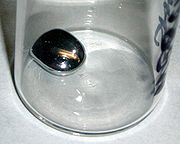- Cohesion (chemistry)
-
 The cohesive character of Water is clearly noticeable in space
The cohesive character of Water is clearly noticeable in space
Cohesion (n. lat. cohaerere "stick or stay together") or cohesive attraction or cohesive force is the action or property of like molecules sticking together, being mutually attractive. This is an intrinsic property of a substance that is caused by the shape and structure of its molecules which makes the distribution of orbiting electrons irregular when molecules get close to one another, creating electrical attraction that can maintain a macroscopic structure such as a water drop.
 Mercury exhibits more cohesion than adhesion
Mercury exhibits more cohesion than adhesion
Water, for example, is strongly cohesive as each molecule may make four hydrogen bonds to other water molecules in a tetrahedral configuration. This results in a relatively strong Coulomb force between molecules. Van der Waals gases such as methane, however, have weak cohesion due only to Van der Waals forces that operate by induced polarity in non-polar molecules.
Cohesion, along with adhesion (attraction between unlike molecules), helps explain phenomena such as meniscus, surface tension and capillary action.
Mercury in a glass flask is a good example of the effects of the ratio between cohesive and adhesive forces. Because of its high cohesion and low adhesion to the glass, mercury does not spread out to cover the bottom of the flask, and if enough is placed in the flask to cover the bottom, it exhibits a strongly convex meniscus, where the meniscus of water is concave . Mercury will not wet the glass, unlike water and many other liquids,[1] and if the glass is tipped, it will 'roll' around inside.
See also
- Adhesion
- Adhesive surface forces
External links
- The Bubble Wall (Audio slideshow from the National High Magnetic Field Laboratory explaining cohesion, surface tension and hydrogen bonds)
References
Categories:- Molecular physics
- Intermolecular forces
- Physical quantities
Wikimedia Foundation. 2010.
